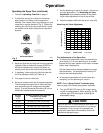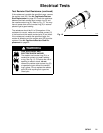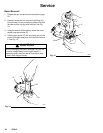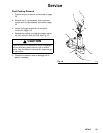
307912 19
Electrical Tests
The performance and safety of the spray gun are
directly affected by the condition of the electrical
components contained inside the gun. The electrical
tests below can be used to determine the condition of
the power supply (18) and the resistor stud (22) as well
as the continuity of the electrical path between the
components.
Use megohmmeter P/N 241079 (A) and an applied
voltage of 500 volts to complete these electrical tests.
Connect the leads as shown.
WARNING
FIRE, EXPLOSION, AND
ELECTRIC SHOCK HAZARD
Megohmmeter P/N 241079 (A-see Fig.
7) is not approved for use in a hazard-
ous area. To reduce the risk of sparking,
do not use the megohmmeter to do
electrical tests unless:
D The gun has been removed from the
hazardous area;
D Or all spraying devices in the hazardous area
are turned off, ventilation fans in the hazardous
area are operating, and there are no flammable
vapors in the area (such as open solvent con-
tainers or fumes from spraying).
Failure to follow this warning could cause fire,
explosion, electric shock and result in serious injury
and property damage.
Test Gun Resistance
Check the resistance with the gun triggered and with
the trigger released. The fluid passage must be
flushed and dried to get an accurate reading.
Measure the resistance between the end of the elec-
trode (20) and the gun air fitting (17). See Fig. 7. The
resistance should be between 180 to 220 megohms. If
the resistance is outside the specified range, go to the
next test. If the resistance is correct, resume spraying
or refer to the Electrical Troubleshooting chart on
page 18 for other possible causes of poor perform-
ance.
Fig. 7
17
20
A
06447B
Continued on the next page.


















